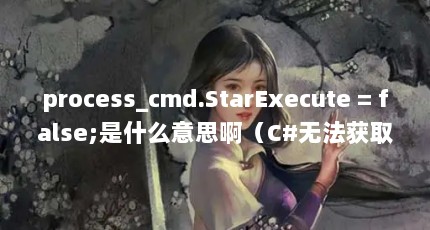
大家好,今天小热关注到一个比较有意思的话题,就是关于UseShellExecute的问题,于是小编就整理了3个相关介绍UseShellExecute的解答,让我们一起看看吧。
文章目录:
一、process_cmd.StarExecute = false;是什么意思啊
process_cmd.StarExecute = false; 这行代码的意思是禁用了使用 ShellExecute 功能。具体来说:
- 禁用 ShellExecute:当 UseShellExecute 设置为 false 时,意味着不能使用 ShellExecute 来打开文件。ShellExecute 通常用于打开各种类型的文件,包括可执行文件和非可执行文件。但设置为 false 后,你只能启动可执行文件,并且需要提供完整的文件路径。
- WorkingDirectory 属性的变化:在 UseShellExecute 为 true 时,WorkingDirectory 属性用于指定可执行文件的位置。若 WorkingDirectory 为空字符串,则默认当前目录为可执行文件所在。然而,当 UseShellExecute 设为 false 时,WorkingDirectory 属性并不用于查找可执行文件,它只在启动的新进程中起作用,且仅在该进程的上下文中有意义。
- 重定向标准输入和输出:当 UseShellExecute 为 false 时,你还可以重定向进程的标准输入、输出和错误流,这在某些需要与控制台应用程序交互的场景中非常有用。
二、C#无法获取控制台应用程序的输出!
Process p = new Process();
p.StartInfo.FileName = "cmd.exe";
p.StartInfo.Arguments = "/c " + filepath;
//filepath其他控制台程序的路径
p.StartInfo.UseShellExecute = false;
//重定向标准输入
= false;
//重定向标准输出
p.StartInfo.RedirectStandardOutput = true;
//重定向错误输出
p.StartInfo.RedirectStandardError = false;
//设置不显示窗口
p.StartInfo.CreateNoWindow = true;
try
{
//启动进程
p.Start();
//停止3秒钟
Thread.Sleep(3000);
//如果进程结束
//或者你可以等到结束再获取
if (p.HasExited)
{
//从输出流获取执行结果
strRst = p.StandardOutput.ReadToEnd();
}
else
{
p.Kill();
}
}
catch (Exception ex)
{
strRst = "";
}
finally
{
p.Close();
}
三、C# process 执行exe文件 死循环问题
这样改:
string fileName = this.compiler + problemId + userName + ".exe";
StreamReader sr = File.OpenText(this.judgeIn + problemId + ".in");
string test = sr.ReadToEnd();
sr.Close();
DateTime startt = DateTime.Now;
this.p.StartInfo.CreateNoWindow = false;
this.p.StartInfo.UseShellExecute = false;
this.p.StartInfo.FileName = fileName;
this.p.StartInfo.RedirectStandardError = true;
this.p.StartInfo.RedirectStandardInput = true;
this.p.StartInfo.RedirectStandardOutput = true;
Timer timer = new Timer();
timer.Interval = Convert.ToDouble(time);//设置timer间隔
timer.Enabled = true;
timer.AutoReset = false;
this.p.Start();
timer.Start();
this.p.StandardInput.Write(test + '\n');
// string message = this.process.StandardError.ReadToEnd();
string output = this.p.StandardOutput.ReadToEnd();
this.p.WaitForExit();
TimeSpan ts = new TimeSpan();
ts = startt - DateTime.Now;//此处报错 句柄无效
this.p.Close();
timer.Stop();
return output;
到此,以上就是小编对于UseShellExecute的问题就介绍到这了,希望介绍关于UseShellExecute的3点解答对大家有用。
郑重声明:本文版权归原作者所有,转载文章仅为传播更多信息之目的,如作者信息标记有误,请第一时间联系我们修改或删除,多谢。